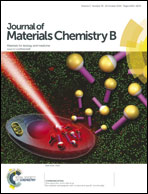Mesoporous organosilica hybrids with a tunable amphoteric framework for controlled drug delivery†
Abstract
The chemical conversion of nitrile groups integrated in the pore wall frameworks of mesoporous organosilica hybrids (MSHs) into either carboxylic acid groups or amine groups by an acid or base hydrolysis method without altering the mesostructural order is suggested. By this approach, bifunctional derivatives could be produced in the silica pore walls. The nitrile groups integrated covalently into the pore walls of the mesoporous organosilica hybrids were converted to reactive functionalities, such as carboxylic acid (–COOH) or amine (–NH2) groups, by treatment with H2SO4 or LiAlH4 as the catalytic reagents. This facile approach allows the production of high amounts of either –COOH groups (3.26 mmol g−1) or amine (–NH2) groups (4.13 mmol g−1) into the pore walls of the mesoporous organosilica hybrids. The synthesised materials were characterised by X-ray diffraction, N2 sorption isotherms, Fourier transform infrared spectroscopy, transmission electron microscopy (TEM), scanning electron microscopy (SEM) and solid state 13C cross-polarization magic angle spinning nuclear magnetic resonance spectroscopy (CP MAS NMR). Owing to the presence of hydrophilic basic diurea functional groups and –COOH or –NH2 derivatives in the pore walls, the obtained samples could behave like bifunctional materials. The mesoporous organosilica hybrids with chemically derivatised carboxylic acid groups or amine functionalities in the pore wall frameworks were found to be suitable drug carriers for the controlled delivery of both hydrophilic (for example, 5-FU) and hydrophobic (e.g. IBU) drugs under an intracellular environment. The biocompatibility of the synthesised materials was also evaluated using 3-(4,5-dimethylthiazol-2-yl)-2,5-diphenyltetrazolium bromide (MTT) assay. The cellular uptake was monitored by confocal laser scanning microscopy (CLSM). These results show that the synthesised materials have potential use as efficient carriers for drug delivery applications.


 Please wait while we load your content...
Please wait while we load your content...